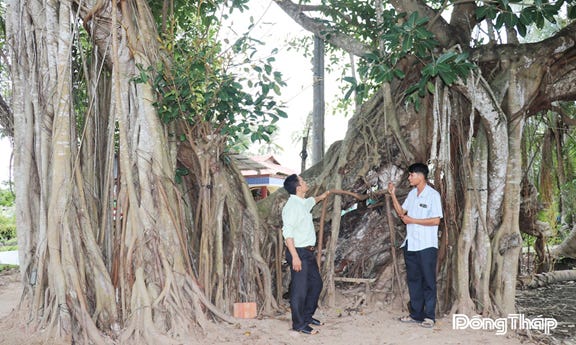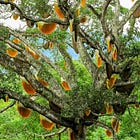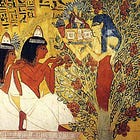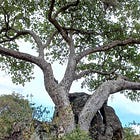Planet Ficus Monthly Roundup #4
Fruit bats in Costa Rica. Giant fig trees in the Philippines. A US fig enthusiast. Sacred trees in Ethiopia. Urban figs in India. An ancient carving. Turkish imaginaries. Figs in dentistry. And more!
Welcome to the Planet Ficus Monthly Roundup
Each month, I’ll bring you stories from around the world that reveal just how extraordinary fig trees are — not just biologically, but culturally, spiritually and artistically.
In this roundup, you’ll find: Costa Rican fruit bats, reforestation in Malaysia, giant fig trees in the Philippines, a US fig enthusiast, a symbolic tree in Ethiopia, urban figs in India, an ancient image of a sacred fig, Turkish imaginaries, figs in dentistry — and much more.
This variety is not random — it’s evidence that fig trees are everywhere in the human story and central to many ecosystems and cultures.
My mission with these roundups is simple: To show you that fig trees are the most interesting, important and awe-inspiring plants on the planet. Thanks for joining me on this journey. I hope these stories surprise and delight you, and maybe even change the way you see the natural world.
Let’s dive in.
Biodiversity, Ecology and Conservation
Here at Planet Ficus, I shared the story of people in the Malaysian state of Sabah who say that planting fig species can revolutionize reforestation and ecotourism by increasing resources for threatened wildlife.
I also wrote about how global warming threatens the 80-million-year-old relationship between Ficus species and their pollinator fig-wasps, with cascading impacts on fig-eating animals and the plants whose seeds they disperse.
Fruit bats are among the most effective seed dispersers of trees in tropical forests. Now, for the first time, they have been observed feeding on fallen figs (Ficus obtusifolia) and other fruit. The finding, captured by camera traps in a Costa Rican tropical dry forest, adds to our understanding of how fruit-eating animals coexist.
In another study, also in Costa Rica, researchers showed that cavities of large fig trees of a species called Ficus crocata are the preferred nesting sites of stingless bees, which are important pollinators of rainforest trees. Five species of stingless bees were found nesting on the fig trees, with up to three species and seven nests per tree. More than 12 percent of the Ficus crocata trees had nests, compared to 1 percent of other tree species.

Food and Cultivation
Robert Rodriguez interviewed a passionate fig-grower called Brian Melton who produces more than 300 distinct varieties of the edible fig (Ficus carica) on his land in Fresno, California.
The Croatian city of Krk held its 19th annual ‘Days of Figs’ festival — a ten-day celebration of the cultural and gastronomic importance of figs.
Researchers in Bangladesh showed that fermenting sun-dried figs of species called Ficus hispida increases their nutritional quality and antioxidant properties. I’ve never tasted a fermented fig — have you?
Heritage Trees
Millie Manahan wrote about strangler figs that are among the biggest and oldest trees in the Philippines. If you have a weeping fig (Ficus benjamina) in your home you may be surprised to see what this plant — called balete in the Philippines — looks like in the wild.
One example, the ‘Wonder Balete’, is thought to be more than 1,300 years old. It would take 42 people, stretching hand to hand, to encircle the tree’s colossal trunk.
Manahan writes: “Imagine a living being older than most nations, older than the Spanish and American eras, older even than the Philippines itself. It has witnessed kingdoms rise and fall, felt the tremors of earthquakes and the roar of typhoons, and stood steadfast through the quiet in-between. At night, fireflies gather to dance around its hollow, like Christmas lights strung by nature’s hand. Inside its massive trunk, lizards scurry, bats roost, and countless insects hum in the dark. It is a world within a world, alive with its own pulse, a hidden city that has thrived for over a millennium beneath the shelter of its gnarled, time-worn bark.”
In Vietnam, recently recognized heritage trees in Dong Thap province include two 300-year-old fig trees. One protected local people from the surging sea during a major storm in 1904, and has survived having its main trunk cut down twice by the French military during Vietnam’s war of independence. Nearby, another huge fig tree served as a shelter for Vietnamese soldiers. It was damaged by bombs, but survived and today has a canopy covering more than 1,500 square metres.

Science and Innovation
Researchers in China showed that three chemicals in extracts of fig leaves (Ficus carica) promote the growth of a widely cultivated medicinal plant called woad (Isatis indigotica).
Dentistry scientists in India showed that extracts of Ficus carica seeds enhance the strength, colour and antimicrobial efficacy of dental resin used to 3D-print provisional crowns and bridges.
Researchers in Peru showed that carbonizing pruned branches of Ficus benjamina fig trees is a viable approach for producing biochar for biofuel or long-term storage of carbon in soils.
Figs in Culture, Art and Storytelling
The soaring columns and wide canopies of slippery blue fig trees (Ficus albipila) have inspired the proposed design of a new arts and cultural centre in Cairns, Australia.
A new film connects the Buddha's sacred fig tree to ecological, spiritual and societal resilience in a warming world. I was honoured to be invited to contribute.
Mallika Ravikumar explained some of the many names for India’s banyan fig trees (Ficus benghalensis) — including bahupada (many feet), mahachaya (great shade) and avaroha nyagrodha (upside-down tree).
Arshad Awan wrote about the sacred fig tree depicted in the Seal of Divine Adoration — an artefact made more than 4,000 years ago by a member of the Indus Valley Civilization in what is now Pakistan. The seal depicts a deity standing within the tree, and a devotee making what appears to be a sacrificial offering.

Urban Fig Trees
Fig trees (Ficus religiosa) are growing from the walls of a major flyover road in Nagpur, India, raising concerns that their powerful roots could damage the structure.
Rainforest rewilder Suprabha Seshan sees urban figs differently. Writing about the proliferation of wild Ficus religiosa trees in Bengaluru, India, she describes them as daring pioneers testing out possibilities for nature to transform the city. Thanks to Jeff Ollerton for sharing this with me.
An iconic fig tree (Ficus carica) that soldiers planted in a crevice in a sea wall in Bangor, Wales during the Second World War has been successfully removed and replanted nearby. Without the move, the construction of new flood defences would have destroyed the tree. A local resident said: “The tree has always felt like part of the soul of Bangor, and now it’s standing in a place that connects us to our history.”
The city of Sydney, Australia published a searchable map of significant trees, including hundreds of fig trees from six species of Ficus. The map provides information on each tree and why it has been included in the register.
Symbolic Figs
Sertaç Sehlikoglu wrote about how fig trees (Ficus carica) in two historically Greek and Jewish areas of Istanbul, Turkey embody contested social imaginaries, revealing deep-rooted tensions over heritage, belonging and identity. She shows how differing imaginative attachments, ranging from reverence to destruction, reflect broader narratives of conquest and coexistence.
Abebe Lemessa Saka wrote about the Odaa fig tree (Ficus sycomorus) as a cultural and spiritual symbol among the Oromo people of Ethiopia. He shows that while the fig tree has embodied collective identity, political resistance and religious reverence, it is now a contested emblem across different Oromo movements.
Over To You
Do you have a memory, photo, or observation involving fig trees? I’d love to hear from you. Send your story or image to planetficus@substack.com — I’ll feature selected entries in future editions.
Thank you for reading Planet Ficus. Like the seeds of fig trees carried far and wide by birds and bats, this newsletter grows best when it’s shared. If you enjoyed this edition, please share it with a friend or invite them to subscribe.






HI mike, some of my oldest figs are less than a meter tall as they make excellent bonsai. I will take some photo's and send them on.
Hi Mike, thankyou for you recent article. Do you have one on Morton bay’s figs, flying foxes and Hendra ? Thanks David.